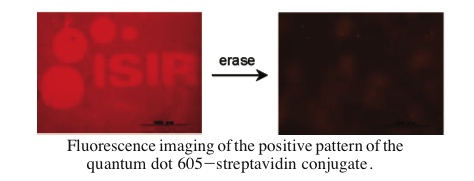Protein nanotech in next gen storage

The magnetic spots in disk storage are already smaller than semiconductor feature sizes, and patterned media and heat-assisted recording will allow 10 TB 2.5" disks in a few years. But then what? Optical protein-based recording could be the answer.
Scientists at a Osaka University lab have demonstrated a photochemical technique for assembling a specific protein on a patterned surface for a rapid method of of recording, reading and erasing of information.
The patterned surface can be manufactured using quantum dot 605-streptavidin conjugates. Under a medium wave UVB laser, the conjugate fluoresces, distinguishing a 1 from a zero.

Mainstream technology This isn't like holographic storage, which is theoretically irresistible but practically almost impossible. Much of today's disk infrastructure - servo, signal processing, stepper - and some of the planned future technology - patterned media and HAMR lasers - is directly applicable to optical protein storage.
The underlying technology is widely used, as the team notes:
Protein patterning on solid surfaces is a topic of significant importance in the fields of biosensors, diagnostic assays, cell adhesion technologies, and biochip microarrays.
The importance of utilizing existing technology, representing thousands of man-years of refinement and billions of dollars of investment, is key. Thousands of engineers know how to work with current technology, speeding adaptation of new techniques.
The Storage Bits take Few appreciate how much the exponential increase in storage areal density has fostered computing advances. As Moore's law has driven processing power, the advance of storage technology has - just barely - enabled massive data stores and rates to feed insatiable processors.
Optical protein storage should be much more stable than magnetic storage as well. Magnetic bits are subject to many kinds of degradation, while proteins can be very persistent, as the prions causing Mad Cow disease have demonstrated.
Much work remains before protein storage sees the light of a commercial introduction. Its importance is that it gives us another tool to advance our ability to preserve and access the information that makes our culture and civilization possible. Professor Tetsuro Majima and his team at ISIR deserve our respect for this breakthrough.
Comments welcome, as always.